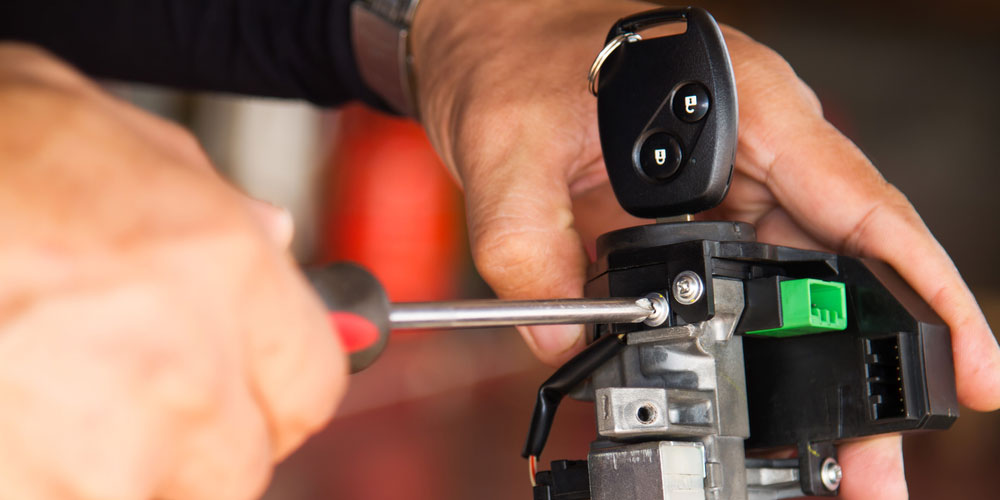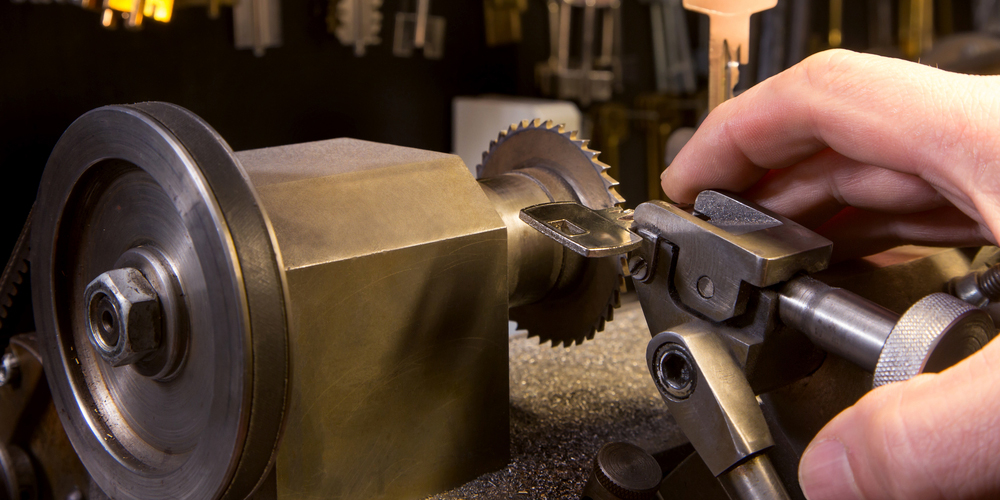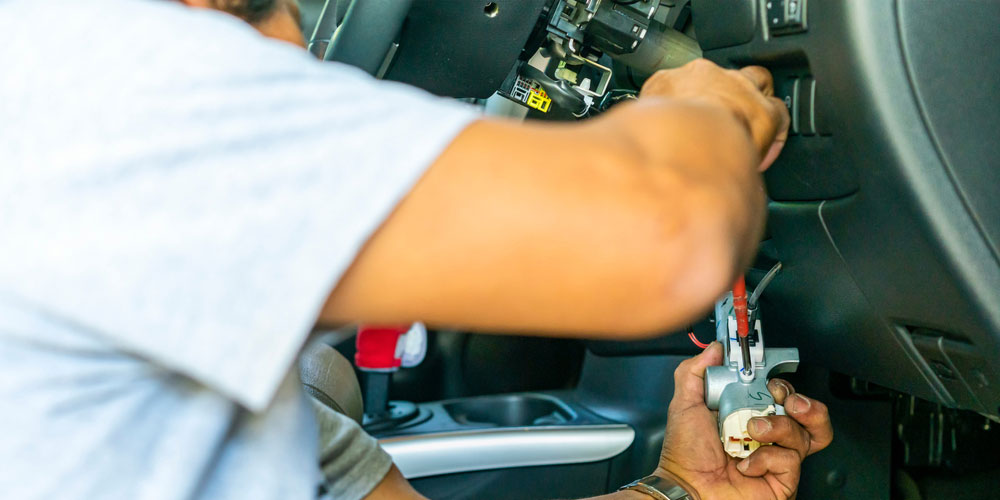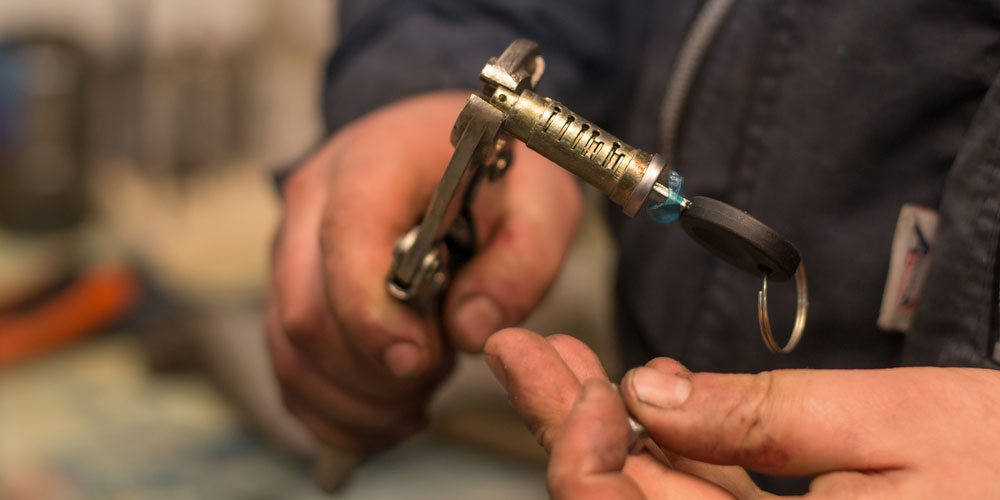Lock Blog
A resource for consumers, locksmiths, and security professionals
A resource for consumers, locksmiths, and security professionals

Is your car key ignition malfunctioning? This may take the form of a key not turning, failing to start, not retaining the key, causing the key to stick, etc. These issues may be solvable with car key ignition replacement. There is a chance you may be able to perform the car ignition replacement yourself, but if you are unsure of anything, it will be best to contact a locksmith.
The basic steps of car key ignition replacement:
There are many situations where car key ignition replacement seems like the simplest or most obvious solution, but this is not always correct. You can try a couple of different, less complicated, and more cost-effective solutions. It is still possible that you will end up needing car ignition replacement services, but see if any of these alternatives work first.
When a car key is stuck in the ignition, there may be no way to remove it without a car ignition replacement. But sometimes simply adding a bit of lubricant to the ignition’s keyway will allow you to pull out any stuck car keys. If you are in an emergency, you can use an oil-based lubricant like WD40, but graphite lubricants are preferred.
Oil-based lubricants collect dirt over time, which can lead to further complications down the line. To avoid car key ignition replacement due to a grime-filled keyway, a dry lubricant such as a graphite spray is recommended. Just be sure to wipe away all drips and overspray as graphite lube can leave very dark stains on whatever it comes in contact with.

The internals of a lock cylinder are not always to blame for the malfunctioning. In some cases, the key is responsible for the issue. This is almost always the result of wear on the key blade. The constant grind of insertion and removal will change the grove depths so the key no longer raises the wafers properly. Instead of a key ignition replacement, which likely will require new keys as well, just replace the car key.
You can test if the key is the issue by using your spare. With no spare car key, you will not be able to take the worn key to the key duplication machines in hardware or retail stores. A duplicate of a worn key will just clone your problem. Your options for car key replacement will be limited to an auto locksmith or dealership, both of which can cut a new key with the car’s VIN.
There are a number of reasons that you may be led to believe you need a car key ignition replacement, but be sure to do a few simple troubleshooting steps before taking that extreme final step. Though some of these measures may only be temporary solutions, they will provide you a bit more time to come up with a permanent fix. Often these simple to fix issues manifest a car key that won’t turn in the ignition.
As any motorcycle locksmith will tell you, bending keys should be replaced, but they can be temporarily bent back into shape. Always double-check the reasons for your issue isn’t the wheel lock by rocking the key as you twist the wheel back and forth. Check that nothing is interfering with the transponder signal from either the key or the ignition by using a spare key and looking for signs of other electrical issues.
As with every car-related service, the specifics will vary depending on the make, model, and manufacturer of the vehicle. However, there is a general process that can be followed as a low-resolution image of the overall steps. For a higher resolution picture of all the steps for the car key ignition replacement of your vehicle, consult your owner’s manual or a professional locksmith.
Process Overview:
Whether it is with a working key, or through other means, the cylinder must be rotated to the accessory position before the ignition cylinder can be removed. This will prove difficult if the key is stuck in the ignition and will not turn, or if a key cannot be inserted. If the car key broke off in the ignition, or something else is obstructing the keyway, that must be cleared.
A car key stuck in the ignition can be rapped gently with a hammer as it is turned so that the cylinder moves into the accessory position. Lubrication may allow the cylinder to turn easier. And if the ignition cylinder is hopelessly broken, it can be drilled and turned. Exercise extreme caution when drilling or striking your key with a hammer as certain forms of damage will make the key ignition replacement more difficult.
Process Overview:
Each car has an order of operations for removing dashboard cover panels. This order will also need to be reversed during reassembly, so document it as needed. Make sure that screws and fasteners are saved for their respective panels, and do not pry anything too vigorously as you run the risk of it breaking. If you run into any problems contact a locksmith before attempting to move on through the car key ignition replacement process.
This is likely to be the most time-consuming section of the car key ignition replacement because of the number of panels and the variety of ways they come apart. Some panels may even need specialty screwdrivers as newer cars use security screws to fasten dashboard covers. And in other cases, the panels can simply be pried without removing fasteners.

Process Overview:
With all of the dashboard coverings removed around the steering column, you should be able to see the exposed ignition housing. Investigate the housing to find the cylinder retention pin. The pin should be depressable with the cylinder rotated to the accessory position. Push the pin in and use pull the key out without rotating (it should retain so the cylinder is removed).
The retention pin may be obscured or placed in a non-obvious location, such as beneath the ignition housing. You will also need a tool to press in the pin. A pen should work, but it may need to be a longer and/or thinner tool. This tool will also need to be strong enough as not to bend while it is being forced down into the pinhole.
Process Overview:
To install the new ignition, the process is going to mirror the removal steps with some important adjustments. Begin by putting the new key into the replacement ignition cylinder. This is to be done with the cylinder still outside of the ignition housing. In order to place the cylinder into the housing, the new key will need to be rotated into the accessory position.
Push the cylinder into the housing until you hear the distinct click of the retention pin moving into place. With the cylinder secured, you can now remove the key without incident. But before you remove the key, there are some tests you should perform. Leave the key in the ignition and move on to the next step.
Process Overview:
With the key still in the accessory position, attempt to pull it out. If the retention pin has not been secured, the cylinder will pull free. Now that you know the cylinder is fastened into the housing, start the car. Turn the car off, pull the key out, then repeat the process. You want to make sure there are no issues with the ignition before you go through the hassle of putting the dashboard covers back on.
If something is not working, your problem might not have been the ignition cylinder, and it is time to call a mechanic. When everything is working, it is time to reattach the covers for the steering column and dashboard. Be very careful, as it is possible to detach wiring during this process. Damaged electronics could undo the work of the car key ignition replacement as well as create more serious problems for the vehicle.
I wish that every car key ignition replacement started and ended with the car ignition replacement service, but that is very rarely the case. It is extremely common that customers will require additional services surrounding their car key ignition replacement. Some of these options will be possible to do yourself, whereas others will require a locksmith.

Your new car key ignition will not work with the key to your previous car key ignition. But a new ignition cylinder can be rekeyed so it will accept the old key. As long as the new and old cylinders both use the same style of key blank, they can be keyed the same. If the wafers/tumblers in the old lock are still functional, they can be used to replace what is inside the new cylinder.
Though you may be able to handle the car key ignition replacement yourself, without working wafers that can be repurposed, you will need a locksmith to rekey the ignition. Properly replacing these internal components is imperative, or you may end up needing another car ignition replacement.
If you choose not to rekey the ignition to work with the existing key, you can use the new ignition key that comes with the replacement ignition. However, the vehicle may still require a transponder signal in order to start the car. This eventuality will require transponder key programming.
Most modern car keys use transponder chips, which are concealed in the plastic bow cover on the key. If you have a plain metal key, you don’t have to worry about programming. Removing the transponder functionality of your ignition is not recommended because this does provide additional security.
When you elect not to rekey your ignition cylinder after a car key ignition replacement, the car doors will be keyed differently from the ignition. To limit the number of car keys on your keychain and reduce confusion, you may want to update the door locks. The options will be to either replace your car door lock cylinder or rekey your existing door locks.
When purchasing your car key ignition replacement cylinder, you can buy keyed-alike door lock replacements and install those as well. To save money on replacement parts, you can call a locksmith to rekey the car door locks. Similar to rekeying an ignition, the locksmith is going to be your best option to rekey car door locks because of their access to internal component parts.
In some cases, a car key stuck in the ignition is going to interfere with the key ignition replacement service. This means you may need to undergo a car key extraction before the replacement can be underway. This is the case when a key breaks and prevents a new key from being inserted.
Most cylinders will need to be rotated to the accessory position in order to remove the ignition cylinder, which requires a working key, lock picking, or drilling. All of these options require a keyway clear of metal obstructions. You can look into the various ways to remove a broken key from a lock yourself or have a locksmith perform all necessary services.
Though ignition switch replacement and ignition cylinder replacement are often synonymous in a customer’s mind, they are separate services. The cylinder is the mechanical element of the ignition with wafers that the key lifts so the cylinder can rotate. The switch is the electrical component that causes the ignition to turn over when the cylinder is rotated.
Car key ignition replacement will often refer to the replacement of the cylinder, as these are more prone to damage than the wiring or electrical connections. If replacing the cylinder does not solve the issue, investigate the electrical end of things and determine whether or not you need to replace your ignition switch as well.
The most pressing concern is whether to internalize all of this information and attempt the key ignition replacement process yourself or hire a locksmith. When you do the work yourself you save money on the labor costs. But you also assume all the risk of damaging your car. Potentially doing harm to the point where the vehicle is rendered inoperable.
An automotive locksmith has the tools and training to get the job done right. And not just car key ignition replacement, but all the intersecting services that you are almost certainly going to need. To get the job done right and make sure you get back on the road, contact the best locksmith for ignition replacement near you. Call United Locksmith today!
Category: Automotive, Car Keys